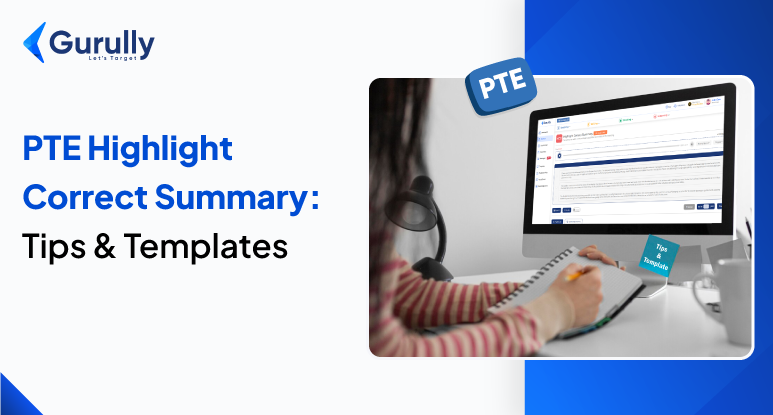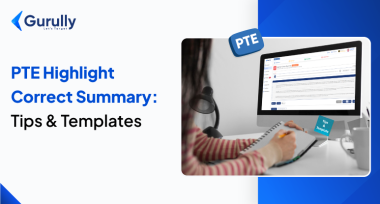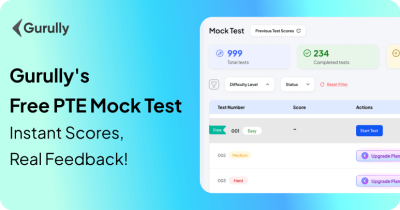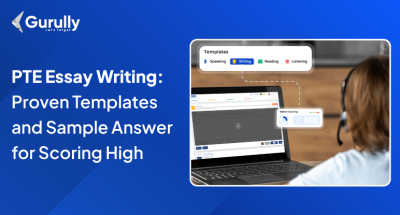You might be preparing for PTE Academic for studying abroad, as this is the most convenient exam that will help you achieve your dreams. Though every section is important for scoring high, some question types need extra attention. One of the tasks that might be a bit challenging for test-takers is the PTE Highlight Correct Summary question. It may seem straightforward, but it tests your listening skills and ability to comprehend and summarize key ideas efficiently.
But don’t worry—we’re here to help you ace this task! Read to learn essential tips, tricks, and templates that will help you crack PTE with high score in highlight the correct summary question.
What is the PTE Highlight Correct Summary Question Type
In PTE listening highlight correct summary question type, you will hear a short audio recording, and based on it, you need to choose the correct summary from multiple options provided. The summary should accurately capture the essence of the audio without missing important details or adding irrelevant information.
Prompt Length: 30-90 seconds
Why Is It Important?
- The Highlight Correct Summary task is crucial because it assesses your ability to:
- Understand spoken English at a native or academic level
- Comprehend key points and supporting details
- Differentiate between main ideas and examples
- Summarize information concisely and accurately
- These skills are important for the PTE exam and valuable for academic and professional success.

Get instant AI-powered analysis to track strengths, weaknesses & improve
- Personalized AI Insights – Understand your strengths & weaknesses instantly
- Smart Progress Tracking – Monitor improvement with in-depth analysis
- Boost Your Score Faster – Focus only where it matters most
Proven PTE Listening Highlight Correct Summary Tips
Listen for the Main Idea
- Focus on the core message of the audio. Ask yourself, “What is the speaker trying to convey?”
- Ignore filler information and examples that are not central to the summary.
Take Quick Notes
- Jot down key points like names, dates, important facts, or any repeating words.
- Write down any connectors or words that signal the flow of ideas like “however,” “therefore,” and “in conclusion.”
Beware of Distractors
- Incorrect summary options may contain parts of the audio but will distort the main idea.
- Look out for exaggerated details or summaries that focus too much on minor points.
Don’t Rely Completely On Your Memory
Even though the audio plays only once, rely on your quick notes rather than trying to remember every detail. Summaries should capture the “big picture,” not every small fact.
Eliminate Wrong Answers
- If an option includes details not mentioned in the audio, it’s likely incorrect.
- If an option focuses on only a portion of the audio rather than the entire message, it’s also probably wrong.
Tricks for Quick and Accurate Summary Selection
- Use Structure Clues: Listen for phrases like “the main point is…” or “in summary,” which signal important ideas.
- Check the Tone: Sometimes, the speaker’s tone (positive, negative, neutral) can help you eliminate options that don’t match the speaker’s attitude.
- Identify Repeated Words or Phrases: If a word or idea is repeated in the audio, it’s likely central to the main message and should appear in the correct summary.
- Be Wary of Lengthy Summaries: Correct answers are usually concise. It may be wrong if a summary option is too long or overly detailed.
Ready-to-Use Template for Summarizing Audio
Here’s a simple yet effective template for taking notes during the PTE Highlight Correct Summary task. By organizing your notes, you’ll be better prepared to spot the right summary option.
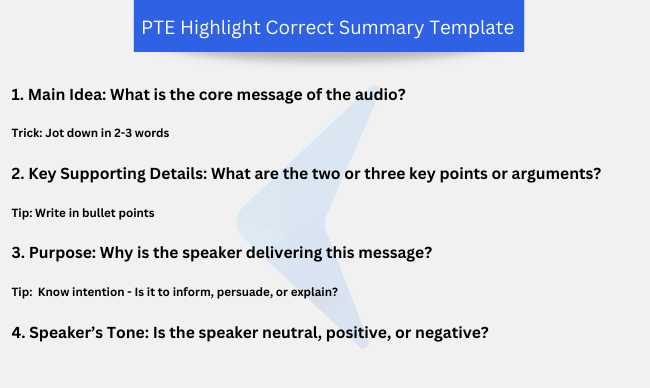
Example Practice
Let’s practice using this template with a sample audio task.
Audio Summary Example:
Main Idea: Climate change’s impact on agriculture
Key Supporting Details:
Increased temperature affects crop yields.
New farming techniques are being developed to adapt.
Purpose: To inform about ongoing agricultural challenges and solutions.
Speaker’s Tone: Neutral with a hint of concern.
Now, based on these notes, you can easily pick out the correct summary option from the choices provided.
Additional Tips to Boost Your PTE Score
- Mock Tests: Practicing with real exam-like conditions is key to your success. Use platforms like Gurully to take PTE mock tests, refine your listening skills, and practice multiple summary tasks before the exam.
- Focus on Time Management: While accuracy is important, remember that time is limited. The more you practice, the better you’ll be at balancing speed with accuracy.
- Revise Your Mistakes: Review why you answered a summary question incorrectly. This will help you understand common pitfalls and improve with each attempt.
Know How Scoring Is Done In PTE Highlight Correct Summary
Your response to this question type will be evaluated on your ability to analyze, comprehend, and combine information from the recording. Your answer will be scored as correct or incorrect. No credit is given for no response or incorrect response.
- Correct response- 1
- Incorrect response- 0
Note :
- The PTE highlight correct summary will affect the scoring of both listening & reading.
- Your speaking and writing skills are not tested in this question type.
Scoring high in the PTE exam is easy if you are practicing well. For PTE exam preparation, you can use Gurully’s online practice platform. Here, you will get full-length mock tests curated by exam experts. Along with that, you will experience real-time exam simulation to be ready for the future.
Your mock test results will be evaluated through AI so that you will get accurate results instantly. Along with full-length mock tests, you will get separate section-wise tests and question-wise practice. You can also practice from your phone through our free PTE practice application.
Conclusion
The PTE Highlight Correct Summary task requires test-takers to listen to a short audio recording and choose the correct summary from the given options. It assesses listening skills, comprehension, and summarization abilities. To excel in this task, focus on the main idea of the audio, take quick notes, and be wary of distractors. Use structure clues, check the tone, identify repeated words, and be cautious of lengthy summaries. Following these tips and practicing regularly can effectively tackle the PTE Highlight Correct Summary task and improve your overall PTE score.
FAQ:
What is the Highlight Correct Summary in PTE?
How to get 79+ in PTE Writing?
How much is 7.5 in PTE?
Is PTE 70 good?
How to score 80+ in PTE?
Also Read:
- PTE Summarize Written Text Template With Predictive Questions & Answers to Score High
- Introduction In PTE – Things You Need To Know For Making A Strong Impression
- PTE Speaking Test Questions & Sample Answers For Preparation
Boost Your PTE Score with These Free Practice Tests:
